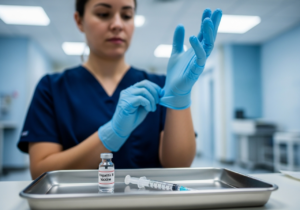Understanding Rabies: A Preventable Yet Fatal Disease
Rabies is one of the oldest known infectious diseases, yet it remains a significant public health concern in many parts of the world. Caused by the rabies virus, it’s almost always fatal once symptoms appear. However, what makes rabies particularly tragic is that it is entirely preventable — thanks largely to advances in vaccine science.
Travellers heading to regions where rabies is still endemic often overlook the importance of vaccination, mistakenly believing the risk is minimal. For healthcare professionals and travel clinics, understanding the science behind the rabies vaccine is not only crucial for accurate guidance but also for ensuring patients comprehend the seriousness of the disease.
How the Rabies Virus Works
To appreciate the role of the vaccine, it’s helpful to understand how the rabies virus behaves. Rabies is a zoonotic virus, meaning it spreads from animals to humans, typically through the bite or scratch of an infected animal. Dogs are the most common source globally, although in some countries, bats, foxes, and monkeys can also be carriers.
Once the virus enters the body, it travels along peripheral nerves toward the central nervous system. This process can take weeks or even months, depending on factors like the proximity of the bite to the brain and the viral load. Once it reaches the brain, the virus causes acute encephalitis — a rapid and severe inflammation of the brain — which is almost universally fatal.
The Role of the Rabies Vaccine
The rabies vaccine works by training the immune system to recognise and fight off the virus before it reaches the nervous system. It does this by introducing an inactivated (killed) form of the virus, which cannot cause disease but is enough to stimulate a robust immune response.
There are two primary uses of the rabies vaccine: pre-exposure prophylaxis (PrEP) and post-exposure prophylaxis (PEP).
Pre-Exposure Prophylaxis (PrEP)
This is recommended for individuals at higher risk of exposure, such as:
– Travellers going to rural areas in countries where rabies is common
– Veterinarians and animal handlers
– Laboratory staff working with the rabies virus
– Children living in high-risk areas
Pre-exposure vaccination doesn’t eliminate the need for further treatment if exposure occurs, but it simplifies the response and improves the prognosis. It gives the immune system a head start, buying valuable time.
Post-Exposure Prophylaxis (PEP)
If someone has been bitten or scratched by a potentially rabid animal, immediate medical attention is essential. Post-exposure prophylaxis involves a series of rabies vaccinations — and sometimes rabies immunoglobulin — administered over a few weeks. When given promptly, PEP is nearly 100% effective at preventing the onset of rabies.
For individuals who have received PrEP, the post-exposure protocol is shorter and less complex, which is especially important in areas where access to medical care may be limited.
What Makes the Rabies Vaccine So Effective?
Modern rabies vaccines are highly purified and well-tolerated. Unlike older versions that were derived from nerve tissue and had significant side effects, today’s vaccines are made using cell culture techniques, resulting in a much safer product.
The vaccine targets the rabies virus glycoprotein — a part of the virus that allows it to attach to and enter host cells. By generating antibodies against this glycoprotein, the vaccine prevents the virus from establishing itself in the body.
Most people develop an adequate immune response within two to four weeks of completing the primary vaccination series. Booster doses may be recommended every few years for those at continued risk of exposure.
Why Travellers Shouldn’t Overlook Rabies Vaccination
For many travellers, especially those heading off the beaten path, the risk of encountering animals that could transmit rabies is often underestimated. In countries across Asia, Africa, and Latin America, rabies remains endemic, and access to timely post-exposure treatment may be limited or non-existent.
Children are particularly vulnerable due to their natural curiosity and tendency to get close to animals. They’re also less likely to report minor bites or scratches, which can delay treatment.
Even short-term travellers should consider the vaccine if they’re planning activities like trekking, cycling, or volunteering with animals. The cost and inconvenience of dealing with a potential exposure abroad far outweigh the time and effort of getting vaccinated beforehand.
Common Misconceptions About the Rabies Vaccine
One of the persistent myths is that the rabies vaccine is painful or dangerous. While the older nerve-tissue vaccines did carry more risks, today’s vaccines are safe and generally well tolerated. Side effects are usually mild and may include soreness at the injection site or temporary fatigue.
Another misconception is that rabies is only a concern in remote or undeveloped areas. While urban centres may have better control measures, stray dog populations and wildlife can still pose risks. Additionally, certain tourist hotspots are located near high-risk zones where the virus circulates among animals.
Integrating Rabies Vaccination Into Travel Health Planning
From a clinical perspective, rabies vaccination should be considered early in the travel consultation process. It’s not a last-minute add-on but a core component of preventive healthcare for specific destinations and activities.
Healthcare providers should assess individual risk based on the traveller’s itinerary, planned activities, and access to medical care. It’s also important to educate travellers about animal avoidance strategies and the steps to take if they are bitten or scratched abroad.
Final Thoughts on the Importance of Rabies Vaccination
In the field of travel medicine, rabies stands out as a disease that is both terrifying and entirely preventable. The science behind the rabies vaccine is robust, and its effectiveness has saved countless lives. For travellers, being proactive about vaccination isn’t just about ticking a box — it’s about safeguarding their health in places where medical support may not be readily available.
If you’re planning international travel, especially to regions where rabies is still a threat, it’s worth having a conversation with a travel health specialist. Getting vaccinated could be one of the simplest, most impactful decisions you make before your journey.
To find out more or to arrange a consultation, you can book your rabies vaccine appointment here. Safe travels, and stay protected.






